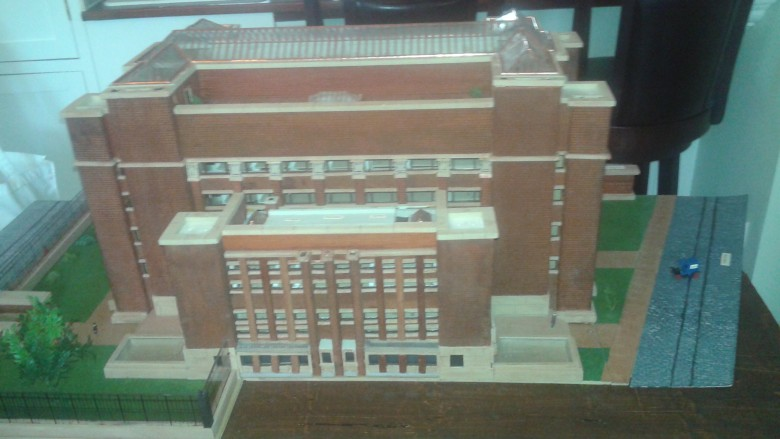The Larkin Building was completed in 1906. A major commercial commission for Frank Lloyd Wright, it radically departed from the conventions of office buildings at that time. Much to the dismay of architects and preservationists, this remarkable building was demolished in 1950.
Buffalo's own Frank Lloyd Wright scholar Jack Quinan published Soap Opera: The Larkin Building in the August, 2016 issue of Architectural Digest. In it he describes some of the unique and innovative aspects of Wright's design:
"...arranged the office areas in and around a five-story light court surrounded by balconies, where secretaries and typists answered mail, and placed the executives on the main floor of the atrium in full view of the 1,500 workers. Wright met the company’s principal concerns about fire safety and worker satisfaction by designing custom metal office furniture and trimming interior surfaces with magnesite (for sound reduction) throughout, as well as installing one of the first air-conditioning systems in a business building in the country, to seal out the pollution from its industrial surroundings. He also provided dining facilities atop the light court. In a bi-nuclear plan, the architect separated business functions in the main block from the various social spaces in the annex, where a branch library, a classroom, locker and restrooms, and a lounge were located.
"But what really distinguished the building was the architect’s articulation of its major functional elements—the main building and the annex, the six corner stair towers, the intake and ventilation stacks, and the piers containing air-circulation ducts—meticulously proportioned, unadorned masses that expressed the power of a major American company. For Wright, the Larkin Building was an opportunity to contradict the horizontal open quality that characterized his prairie houses and to demonstrate that he was capable of just about any architectural challenge."
Quinan also documents the mixed reviews the building received from the architectural community, and in particular, a devastatingly negative review by renowned architect Russell Sturgis, as well as Wright's forceful and public response to it.
If you are the least bit curious about the stunning Frank Lloyd Wright structure which once occupied the now vacant lot at 680 Seneca Street, read the entire article: http://www.architecturalrecord.com/articles/11797-soap-opera-the-larkin-building.
And keep an eye out for a special treat. Until we manage to re-construct the Larkin Admin Building, Arlan Peters' miniature masterpiece will serrve to fill this large hole on Seneca Street.
Working from Wright's original blueprints and a massive amount of research, Peters spent more than 1,000 hours creating a scale model of the Larkin Admin Building, right down to the (literally) tiniest detail. The roof lifts off to reveal the interior, and one wall can be removed, as well. It is absolutely exquisite.
My inadequate photographs do not do it justice, but will have to do until Peters finds a public home for this tiny gem. This remarkable tribute to a lost masterpiece has been completed so recently that it is not (yet) even on public display.
Stay tuned. Perhaps this confluence of attention will inspire a very important re-construction project right on the original site at 680 Seneca Street, in the heart of the burgeoning Hydraulics District, adjacent to Larkin Square.
We now have the boathouse and the gas station, which were not built; it is time to re-build what we destroyed. In full size, not just miniature.

